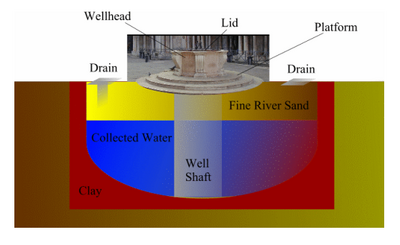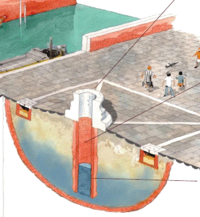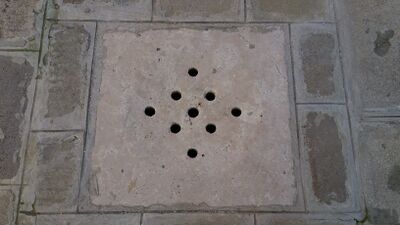Well: Difference between revisions
| (37 intermediate revisions by 2 users not shown) | |||
| Line 1: | Line 1: | ||
''This page contains information about a typical Venetian well. | ''This page contains information about a typical Venetian well. For information on the history of wells, see [[Wells]]'' | ||
[[ | |||
==Structure== | A well is a water system built by Venetians to collect and filter rain to be stored as freshwater. | ||
[[Image:Diagram of Cistern.png|400px|right|none|thumb|Diagram of a typical cistern below a wellhead. <ref>Blackwell, Lewis et al. Preserving Venetian Wellheads. 2000. Pg 21</ref> ]] | |||
== Structure == | |||
A typical well has an underground cistern, a well shaft, drains and a layer of fine river sand between the cistern and the pavement. | A typical well has an underground cistern, a well shaft, drains and a layer of fine river sand between the cistern and the pavement. | ||
[[ | [[File:Pozzi.png|200px|thumb|none]] | ||
=== Well Shaft === | |||
The well shaft is the cylindrical hole extending down from the wellhead into the cistern. Water collected at the bottom of the well shaft once it was filtered and the citizens would retrieve this filtered water from the wellshaft through the wellhead at the top. The shaft was built of semi-porrous bricks, called pozzali, that would filter water as it made its way into the shaft. | |||
=== Cistern === | |||
The cistern is the large bowl shaped tank that holds the water while it is being filtered. It is traditionally made with large stones and lined with impermeable clay that prevented the fresh water from leaking out and more importantly prevented salt water from infiltrating and contaminating the water supply. | |||
=== Drains === | |||
The drains are the grates with holes located in low points around the wellhead. Typically there are two or four drains made of either Istrian Stone or Aurisina opposite each other surrounding the wellhead. Under each drain is a small basin to collect rainwater. These basins are built out of ''pozzali''so that the water leaves behind any particulate matter on its way into the filtration bed. | |||
The image below shows a picture of a drain. | |||
[[File:welldrain.jpg|none|400px]] | |||
=== Filtration Bed === | |||
The filtration bed of the well refers to the mix of sand and clay and stone contained within the cistern that the rainwater flows through and gets filtered on its way to the well shaft. | |||
=== Wellhead === | |||
The wellhead is the only part of the cistern system above ground. It is the decorative stone structure, commonly in the middle of ''campi'', that citizens of Venice used to retrieve their drinking water from. | |||
== Filtration System == | |||
Beneath each well's drainage holes, there are small basins to collect rain water. These basins are made from a semi-porrous brick called ''pozzali'' which filtered water as it seeped through the brick and a mostly waterproof mortar that helps facilitate filtration through the bricks. Once the collected water travelled through the bricks, it would flow through the deposit of sand and gravel that took up most of the volume of the well. The center shaft of the well was made of the same brick as the rainwater basins. This allowed for additional filtration as the water entered the shaft. | |||
== See Also == | |||
*[[Wells]] | |||
*[[Wellhead]] | |||
*[[Wellheads]] | |||
== | == Reference == | ||
<references/> | |||
== External Links == | |||
*[http://en.wikipedia.org/wiki/Water_well English Wikipedia page on Well] | |||
[[Category:Wellheads]] | |||
[[Category:Functional Artifacts]] | |||
[[Category:Public Art]] | |||
Latest revision as of 18:52, 10 December 2025
This page contains information about a typical Venetian well. For information on the history of wells, see Wells
A well is a water system built by Venetians to collect and filter rain to be stored as freshwater.

Structure
A typical well has an underground cistern, a well shaft, drains and a layer of fine river sand between the cistern and the pavement.

Well Shaft
The well shaft is the cylindrical hole extending down from the wellhead into the cistern. Water collected at the bottom of the well shaft once it was filtered and the citizens would retrieve this filtered water from the wellshaft through the wellhead at the top. The shaft was built of semi-porrous bricks, called pozzali, that would filter water as it made its way into the shaft.
Cistern
The cistern is the large bowl shaped tank that holds the water while it is being filtered. It is traditionally made with large stones and lined with impermeable clay that prevented the fresh water from leaking out and more importantly prevented salt water from infiltrating and contaminating the water supply.
Drains
The drains are the grates with holes located in low points around the wellhead. Typically there are two or four drains made of either Istrian Stone or Aurisina opposite each other surrounding the wellhead. Under each drain is a small basin to collect rainwater. These basins are built out of pozzaliso that the water leaves behind any particulate matter on its way into the filtration bed.
The image below shows a picture of a drain.

Filtration Bed
The filtration bed of the well refers to the mix of sand and clay and stone contained within the cistern that the rainwater flows through and gets filtered on its way to the well shaft.
Wellhead
The wellhead is the only part of the cistern system above ground. It is the decorative stone structure, commonly in the middle of campi, that citizens of Venice used to retrieve their drinking water from.
Filtration System
Beneath each well's drainage holes, there are small basins to collect rain water. These basins are made from a semi-porrous brick called pozzali which filtered water as it seeped through the brick and a mostly waterproof mortar that helps facilitate filtration through the bricks. Once the collected water travelled through the bricks, it would flow through the deposit of sand and gravel that took up most of the volume of the well. The center shaft of the well was made of the same brick as the rainwater basins. This allowed for additional filtration as the water entered the shaft.
See Also
Reference
- ↑ Blackwell, Lewis et al. Preserving Venetian Wellheads. 2000. Pg 21